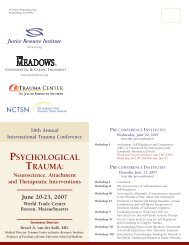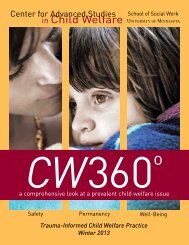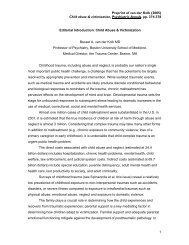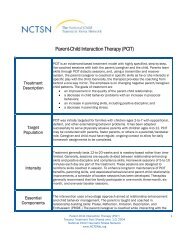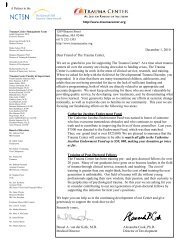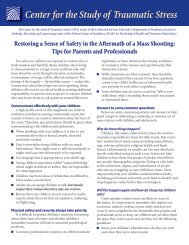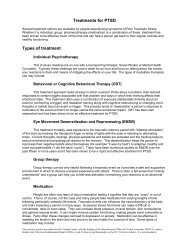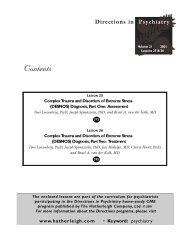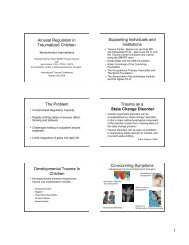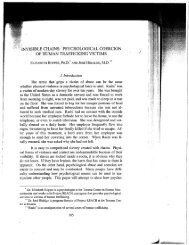ISTSS Expert Consensus Treatment Guidelines for Complex PTSD
ISTSS Expert Consensus Treatment Guidelines for Complex PTSD
ISTSS Expert Consensus Treatment Guidelines for Complex PTSD
Create successful ePaper yourself
Turn your PDF publications into a flip-book with our unique Google optimized e-Paper software.
<strong>ISTSS</strong> <strong>Expert</strong> <strong>Consensus</strong> <strong>Guidelines</strong> <strong>for</strong> <strong>Complex</strong> <strong>PTSD</strong> November 2012<br />
There are currently no published randomized controlled trials of phase-based or sequenced<br />
treatments <strong>for</strong> populations with <strong>Complex</strong> <strong>PTSD</strong> related to adult-onset complex traumas such as<br />
that experienced by refugees and individuals exposed to torture or genocide. Such populations<br />
often have experienced loss of home and material resources, loss of or distance from family,<br />
cultural dislocation, and significant ongoing emotional turmoil and distress. Observations of<br />
these material, social, psychological and emotional circumstances have led to recommendations<br />
<strong>for</strong> sequential or phase-based treatments in which emotional stabilization and resource<br />
development occur be<strong>for</strong>e trauma memory processing (Hinton, Rivera, Hofmann, Barlow, &<br />
Otto, 2012; Nickerson, Bryant, Silove, & Steel, 2011). Preliminary investigations using phasebased<br />
approaches among refugees with <strong>PTSD</strong> and various comorbid symptoms (but not assessed<br />
<strong>for</strong> <strong>Complex</strong> <strong>PTSD</strong>) have suggested that the introduction of emotion regulation strategies,<br />
particularly those focused on somatic experience, facilitates <strong>PTSD</strong> reduction (see Hinton et al,<br />
2012; Morina, Maier, Bryant, Knavelsrud, Wittmann et al, 2012).<br />
A review of Table 1 reveals that stabilization therapies are associated with moderate to large<br />
effect sizes <strong>for</strong> <strong>PTSD</strong>, emotion regulation and social/interpersonal outcomes. Therapies which<br />
include both stabilization/skills building and memory processing generally appear superior to<br />
those which include only the stabilization component. Individual therapies yielded larger effect<br />
sizes than group therapies.<br />
4. Recommendations<br />
The recommended treatment model is a phase-oriented or sequential treatment guided by<br />
a hierarchy of treatment needs assessed prior to treatment. Phase 1 focuses on stabilization and<br />
skills strengthening and has several main functions. The first goal is to ensure that the priority of<br />
7




